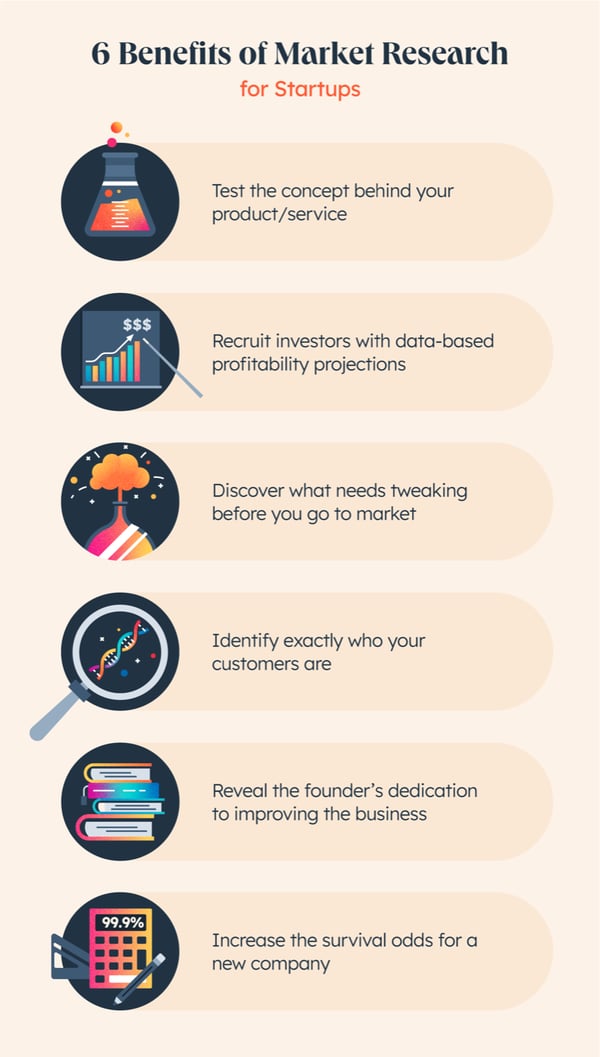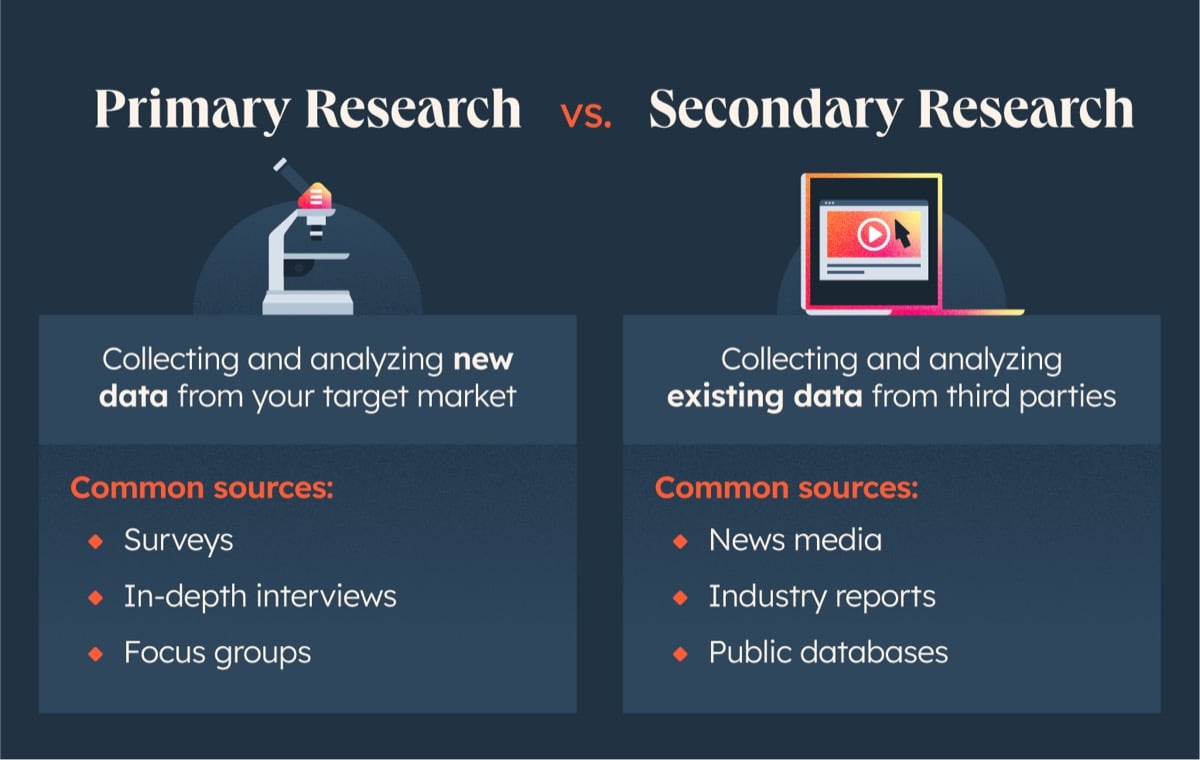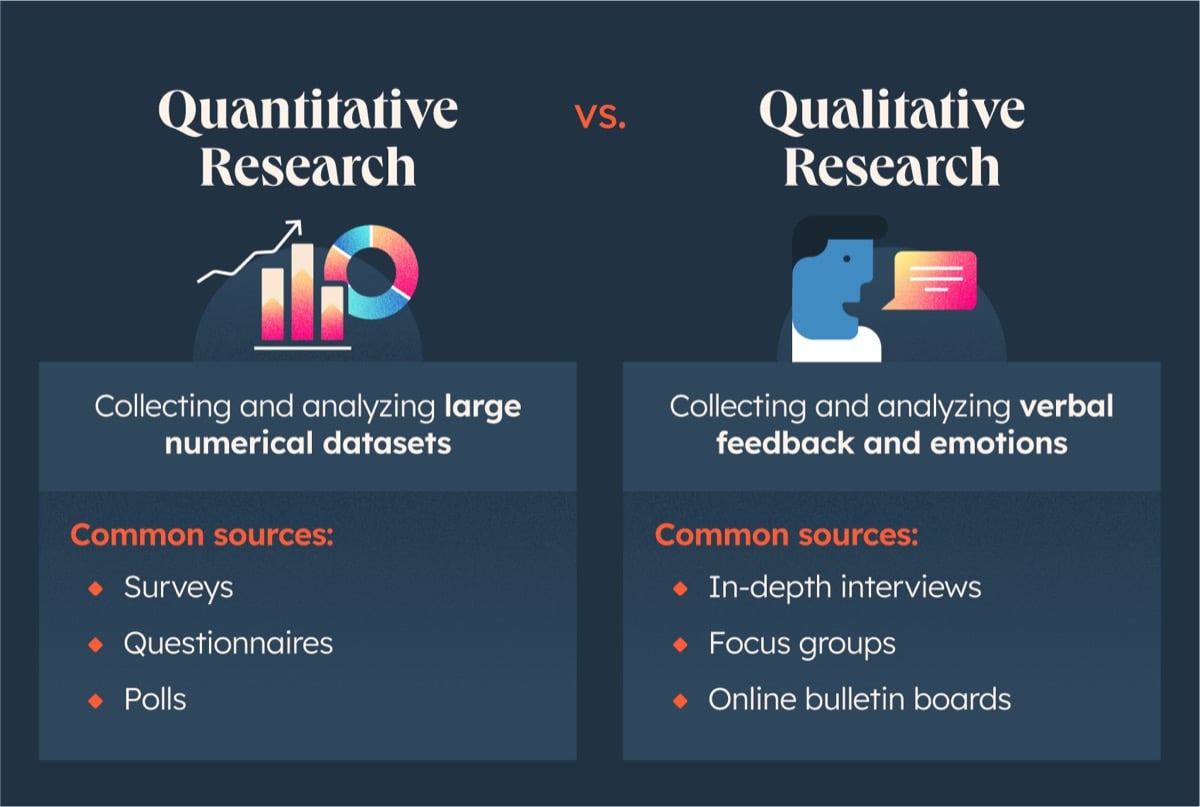With 50% of new businesses failing within the first five years of operation, startups need to develop a deep understanding of their customer base quickly in order to thrive. Successful new business ventures strategically begin by gathering accurate and thorough information about their industry to identify the best path ahead. Conducting market research for startups is a key step toward meeting customer needs and strengthening marketing messaging.
Market research brings together important details about a business's customers, competition, and industry. The results serve as a tool in a startup’s business planning process as it evolves. Analyzing the findings can help determine the viability of a business concept and identify areas for adjustment to improve performance, profitability, and attract investors.
“Without market research, a startup is just making guesses. Listening to your prospective customers will help you align your product/service and marketing messaging to address their needs.”
Dr. Elaine Young, Champlain College Online
As noted by Dr. Elaine Young, professor and program director of marketing communication at Champlain College Online, “Startups need market research so that they can gain insight into the behaviors and values of their target customers. Just because you think your startup idea is amazing, doesn't mean that consumers will. Without market research, a startup is just making guesses. Listening to your prospective customers will help you align your product/service and marketing messaging to address their needs.”
Table of Contents
- What is market research?
- Why is it valuable for startups?
- Types of market research
- Methods of market research
- How to do market research for startups
- Sample questions to ask customers
What is market research?
Market research is defined as the process of collecting, analyzing, and interpreting a broad set of information about a specific market or industry. The research might focus on:
- A potential product or service for that market
- Existing and/or potential customers for the product or service
- The needs, purchase habits, characteristics, and location of your target market
- Competitors in your industry
- Trends within your market or industry as a whole
As a business strategy, market research enables companies to make actionable decisions according to data-based findings. These measurable statistics can be gathered through a variety of methods, which we will explore below.
Why is it valuable for startups?

Startups benefit from market research in multiple ways. With so much time, energy, and funds invested in a startup, taking steps to strengthen the concept and connection to your target audience is critical to survival and the bottom line.
The market research process delivers value to startups by:
- Allowing you to test the ideas and concepts behind your product or service
- Enticing investors with data showing the projected profitability of your venture
- Providing statistical evidence to potentially support your business concept or encourage you to adapt it to better meet the needs of your target market
- Helping to clarify exactly who your customers are
- Serving as evidence to investors of an entrepreneur’s commitment to improving a business based on current market conditions
- Increasing the odds of success of your startup
“Market research can help founders focus their energy, enthusiasm, and resources toward a specific segment and the real target audience.”
Adrienne Wallace, Grand Valley State University
The American Marketing Association confirms that market research can directly increase your bottom line. And trusted market research findings can also speed up the process of getting investors on board with your startup venture.
“Startups can't begin with just a hope and a prayer,” notes Adrienne Wallace, associate professor at Grand Valley State University. “Market research can help founders focus their energy, enthusiasm, and resources toward a specific segment and the real target audience instead of making the age-old error of ‘everyone is the target’ because it simply can't be that for efforts to be fruitful.”
Types of market research

There are two types of market research used most in the business world today: primary and secondary. They can be used individually but are often combined to create a broader understanding of your target market.
Primary research
Primary research involves collecting data directly from your target market. This is often achieved through the use of surveys, interviews, and focus groups. The findings can provide a comprehensive understanding of your customer base’s needs and preferences.
Secondary research
Secondary research requires examining existing data collected by third parties. Examples of potential data sources include news media, industry reports, proprietary data from other companies, academic journals, or public databases. Although targeted data is not always available for your particular industry, secondary research enables you to gain insight and understanding about an industry overall.
Methods of market research

Choosing a specific method of market research — either quantitative or qualitative — will determine the type of data collected in your research.
Quantitative research
Quantitative market research gathers large numerical datasets that can be used in statistical analysis. These results offer more accurate snapshots of industry trends and market challenges. Common methods of collecting quantitative research data are through surveys, questionnaires, and polls.
Qualitative research
Qualitative market research strives to identify the reasons behind customers’ buying habits, as well as their needs, wants, and overall customer satisfaction. These results can help clarify the “why” behind your target market’s behaviors and feelings. Focus groups, in-depth interviews, and online bulletin boards are typical methods for conducting qualitative market research.
Generally, quantitative market research is more commonly utilized than qualitative market research because it is more scientific, unbiased, and more easily plicated in future studies. In 2019, 61% of the money spent on market research in the United States went toward quantitative research, with only 12% spent on qualitative research.
How to do market research for startups

Conducting market research is not a quick process, so it requires thoughtful planning. You may handle this research on your own or hire a third-party market research company to manage the process on your behalf. The steps below will guide you through developing a market research strategy that benefits your startup.
Step 1. Define your research purpose
The first step in market research for startups is to determine what questions you hope to answer through this research. From those questions, you can develop projected results that will help reveal the overall purpose of your research. Understanding the purpose from the beginning will be an asset in identifying the best approach to selecting subjects, composing questions, and testing product designs.
Examples of market research purpose include:
- Confirming consumers’ biggest pain point and whether your product meets their needs
- Tracking and predicting relevant industry trends
- Determining consumer spending capacity for a product/service
- Gauging the market infiltration of your competitors
Step 2. Study your target market and competitors closely
It’s important to take time to study existing information about your target market, your competitors, and your target demographic. Growing your knowledge base about all of these factors in advance will strengthen the relevancy of your research.
When working on demographics, a buyer persona template can be a useful tool to help segment the consumer audience into smaller groups for better targeting. Understanding each group’s behaviors and motivation can lead to research findings that resonate deeply with your customer base.
Step 3. Choose the right type and method for your needs
The best type of market research for your business will depend on the purpose you aim to achieve. If your goal is a broad-scope industry view, secondary research examining existing data may provide you with all the information you need. But if your strategy is to clarify specific details about your customer base, you will need to collect new data through primary research.
The ideal method for data collection also depends on the end goal. Quantitative research methods such as surveys create data useful in making market predictions. Qualitative research methods like focus groups and in-depth interviews offer more personal and subjective responses from participants. Such responses are valuable when seeking direct consumer insight on your product or service and on brand awareness.
Step 4. Recruit appropriate research subjects
If you are pursuing primary research, the subjects involved in your study should be capable of providing insights that are directly relevant and valuable to your market research goals. Recruitment methods can vary from social media posts to hiring third-party market research firms and incentivizing participation.
Seek out existing customers, former customers, and potential customers to create a full spectrum view of your market and product. Other potential sources for research participants include:
- Recent customers
- Customers who did not complete their purchase
- Word of mouth among both personal and professional networks
Step 5. Conduct your research
Execute your market research plan based on the method you identified in Step 3. Appoint someone not deeply connected with the project planning as the point person for interviews or focus groups in an effort to reduce potential bias. When creating surveys, strive to incorporate neutral (non-leading) language as a way to craft unbiased research questions.
Christina Inge, an instructor and curriculum designer at Northeastern University, suggests an effective research technique called customer discovery. “It requires asking customers what their needs are,” she says, “rather than showing them your product or service and asking for their reactions. This can help you get to the heart of what your customers need, leading to better product market fit, faster.”
Step 6. Analyze your results
Once you’ve collected and organized all of your data, analyze it for relevant trends and patterns. Any qualitative data, such as feedback from focus groups or interviews, can be interpreted quantitatively by noting response ratios amongst the participants. Examine your findings for insights that offer actionable next steps.
One famous example of a startup that pivoted toward success as a result of closely analyzing the market research on their target market is Tune In Hook Up. As an online video dating site that wasn’t seeing much traffic, their research revealed that users struggled to share videos easily with one another. Based on their findings, they decided to shift away from romance and focus on the videos, renaming themselves YouTube.
Step 7. Create an actionable report from your findings
Gather your findings into a report that outlines the recommended actions necessary to address the market research results. Whether the data provides positive or negative insights, you should always come away with actionable steps and suggestions for the next stage of your startup.
Find additional tips and a free report template in HubSpot’s’ How To Do Market Research: A Guide and Template.

Sample questions to ask customers
Drafting market research questions for startups is not an exact science because cookie-cutter surveys and interview questions will not work. Every product, service, and industry has unique features that require tailored language in each research question.
Below is a sampling of the type of questions you may want to consider:
- What do you like most about our new product or service?
- What do you wish our product or service did that it does not currently do?
- What do you lose sleep over at night?
- What price would you consider so low that you’d question this product’s overall quality?
- Which of these companies have you purchased this product from in the past six months? (list of competitors)
Market research is a booming industry around the globe, but nowhere more so than in the United States. The U.S. is the leading country for market research services, with the industry bringing in $18.75 billion in 2020, more than six times the industry-related revenue of any other country in the world. It’s no surprise, considering how quality market research can directly impact a company’s bottom line and growth. Free kits for growth marketing can help you get moving on the road to success through market research for startups.





